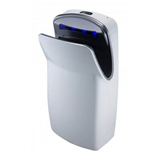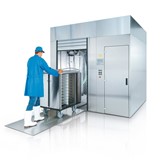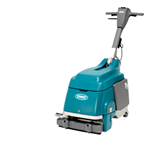Looking to buy a commercial stack washer dryer in Australia? Discover pricing, types, maintenance tips, and industry-specific advice in this guide.
Key takeaways
- Prices start from $6,500 for entry-level commercial stack washer dryers, with premium models exceeding $18,000, depending on brand, capacity, and features.
- Gas-powered units cost 10% to 20% more upfront but offer lower long-term operating costs for high-volume laundries.
- Energy-efficient models with 4+ star ratings can save up to $1,200/year in utility bills compared to older, less efficient units.
- Maintenance costs average $400 to $900/year, with parts like drive belts, heating elements, and water valves commonly requiring replacement.
- Financing options include leasing, chattel mortgage, and commercial hire purchase, with monthly repayments from ~$200/month for a $10,000 unit.
- Units must comply with AS/NZS 60335 standards and meet local council water usage and drainage requirements.
Introduction
Whether you're setting up a new laundromat, upgrading a hotel laundry room, or fitting out an aged care facility, commercial stack washer dryers are a practical solution for saving space while boosting throughput. But with a wide range of models, specifications, pricing, and compliance requirements, it can be difficult to know which unit offers the best value.
This buying guide is built for Australian business owners and facility managers who need clear, up-to-date, and practical insights into purchasing the right commercial stack washer dryer in 2025. We’ll cover everything from pricing and features to maintenance, finance options, and compliance.
Types of commercial stack washer dryers
There are two main types of stack washer dryers used in commercial settings in Australia:
1. Washer-Dryer Combo Units (Integrated)
- Washer and dryer share a single stacked unit.
- Ideal for compact laundries or mobile facilities.
- Typically front-load for efficiency.
- Capacities range from 7kg/7kg to 10kg/10kg.
2. Separate Units (Stacked Installation)
- Two standalone commercial units stacked with a frame.
- Greater flexibility for upgrades or replacements.
- Larger capacities (10kg washer + 10–14kg dryer).
- Often used in higher-volume laundries.
Commercial stack washer dryer prices in Australia (2025)
Here’s a breakdown of average prices based on machine type and specification:
Entry-level (Basic front-load units for light commercial use)
- Price: $6,500 – $8,500
Mid-range (Higher capacity, programmable cycles)
- Price: $9,000 – $13,000
Premium (Heavy-duty, gas-powered, energy/water efficient)
- Price: $14,000 – $18,500+
Additional costs to consider:
- Installation: $500–$1,500
- Delivery: $250–$700 (location dependent)
- Warranty extension: $400–$1,000
How they operate: Components and features
Commercial stack washer dryers are built for speed, durability, and simplicity. Key operational features include:
Washer component
- High-speed front-load drum with programmable cycles
- Inbuilt pump and filter
- Cold and hot water inlet valves
- Auto detergent dispensing system (optional)
Dryer component
- Vented or condenser drying (gas or electric)
- Multiple temperature settings
- Moisture sensors for energy-efficient drying
- Reversible tumbling (premium models)
Control systems
- Digital or touchscreen interface
- Coin/token or card reader compatibility
- Remote diagnostics and error code logging
Maintenance and parts: What to budget for
Routine maintenance keeps your units operating safely and efficiently. Budget between $400–$900/year depending on usage intensity.
Regular maintenance tasks:
- Clean lint filters and drum weekly
- Inspect door seals monthly
- Replace water inlet filters quarterly
- Service heating elements and belts annually
Common replacement parts:
- Drive belt – $60–$120
- Heating element – $150–$300
- Water inlet valve – $50–$150
- Control board – $250–$500
Pro tip: Use OEM parts wherever possible to avoid warranty voids.
Financing options in Australia
Rather than outlay $10,000+ upfront, many Australian businesses opt to finance their commercial laundry equipment. Here are your key options:
Chattel mortgage
- Ownership from day one
- Interest and depreciation tax-deductible
- Rates from 6.5% p.a.
Commercial hire purchase
- Structured repayments with balloon options
- No upfront capital needed
- Better for businesses wanting lower short-term cost
Operating lease
- Off-balance-sheet
- Ideal for facilities needing flexibility/upgrades
- May include maintenance
Example repayment: For a $12,000 unit over 5 years at 6.5%, expect approx. $235/month.
Warranty and after-sales support
Most commercial laundry brands in Australia offer a warranty split between the washer and dryer components:
- Standard warranty: 2 years parts and labour
- Extended warranty: Up to 5 years for some brands
- Service network: National coverage by brands
Questions to ask suppliers:
- Is onsite service included?
- Are spare parts readily available in Australia?
- Can I access emergency breakdown support?
Compliance and certification in Australia
You’ll need to ensure your chosen commercial washer dryer meets Australian safety and installation standards.
Key standards:
- AS/NZS 60335: Electrical safety standards for household and similar appliances
- WELS: Water Efficiency Labelling Scheme, many machines require a WELS rating to comply with council water restrictions
- Gas appliances (if applicable): Must comply with AS/NZS 5601 for gas installations
Other requirements:
- Proper greywater discharge setup for water authority compliance
- Ventilation requirements for heat and moisture dissipation
- Workplace safety signage in laundries (under WHS regulations)
Check with your local council or facility certifier before installation.
Installation and site fit-out considerations
Before you invest in a commercial stack washer dryer, it’s critical to assess whether your facility is physically ready for installation. Overlooking these details can lead to costly delays, rework, or even non-compliance with safety or building regulations.
Here’s what to check:
- Ceiling height clearance: Most commercial stack washer dryers require a minimum ceiling height of 2.4 metres to allow for proper ventilation, lid clearance, and maintenance access. Some high-capacity models may need even more clearance.
- Flooring and load-bearing requirements: These machines are heavy, especially when stacked. Ensure your floor is reinforced concrete or properly engineered to support loads that can exceed 250–300 kg. Raised floors or lightweight substructures may need assessment by a structural engineer.
- Power and water access: Many units require 3-phase power (400V) for commercial performance. Confirm that your facility has the correct electrical infrastructure, as upgrades can cost $2,000–$5,000+. Ensure reliable access to both hot and cold water supplies, with sufficient pressure.
- Drainage and ventilation: Commercial washers discharge water quickly, so proper floor drainage or a plumbed drain is essential. Dryers also require ducted exhaust ventilation to prevent moisture build-up and meet workplace safety standards. If venting externally isn’t possible, consider a condensing dryer model.
Why it matters: Fit-out oversights can blow out your installation timeline or budget. Ensuring your space is compliant and utility-ready helps you avoid unexpected costs, damage risks, or installation cancellations.
Industry-specific recommendations and use cases
Not all commercial laundry needs are created equal. Here’s how to match stack washer dryer configurations to your industry’s typical usage demands, laundry volumes, and hygiene requirements.
Aged care facilities
- Recommended features: Thermal disinfection cycles, gentle wash programs for delicates, and user-friendly interfaces for aged care staff.
- Tip: Choose models compliant with AS/NZS 4146:2000 for healthcare hygiene standards.
- Why: Facilities launder high volumes of linens and resident garments daily with a strong emphasis on infection control.
Hospitality (hotels, motels, Airbnb)
- Recommended features: Large capacity (10kg+), fast cycles, and steam refresh options for towels and bedding.
- Tip: Opt for stack units with coin/card modules if installed in guest-access laundries.
- Why: Quick turnover is critical, especially during peak season. Energy-efficient machines can cut utility bills by 15–25% annually.
Gyms and fitness centres
- Recommended features: Heavy-duty cycle capability, mould-resistant seals, and programmable dosing for disinfectants.
- Tip: Ensure proper dryer venting to handle repeated use of damp towels.
- Why: Towels and activewear require daily sanitisation and frequent cycles during business hours.
Minesite or remote worker camps
- Recommended features: Industrial build quality, high-volume cycles, low-maintenance parts, and remote monitoring capabilities.
- Tip: Prioritise brands with a strong national service network in regional or remote Australia.
- Why: Machines may run 24/7 with minimal downtime tolerance; ease of repair is crucial.
Veterinary clinics and grooming salons
- Recommended features: Pet-hair filters, high-temperature sanitation, and durable inner drums.
- Tip: Choose models with extra rinse cycles and stainless-steel tubs for durability.
- Why: You’ll need to launder hair-covered towels and bedding daily, often with biohazard exposure.
Why it matters: Matching your washer-dryer solution to your industry’s operational and hygiene demands ensures better ROI, longer machine lifespan, and compliance with sector-specific standards.
Frequently asked questions (FAQs)
- Are commercial stack washer dryers more energy-efficient than separate units?
Yes. Most stack units are built with shared control systems and optimised energy/water consumption. Models with 4+ star energy ratings can reduce annual utility costs by 15–25%. - What size stack washer dryer do I need?
- Small cafés or Airbnb: 7kg/7kg combo unit
- Hotels or hostels: 9kg–10kg washer + 10kg+ dryer
- Laundromats or aged care: 10kg+ washer + 14kg dryer capacity
- Should I choose electric or gas dryers?
Gas dryers cost more upfront but are significantly cheaper to run over time. Electric dryers are easier to install. For high-volume operations, gas is usually the better investment. - Can I install these in a residential setting?
Only if your property meets the commercial utility load and drainage requirements. These machines are louder and heavier than residential models. - What brands are most reliable in Australia?
Speed Queen, Maytag, IPSO, and Electrolux are widely used across commercial laundries and offer strong after-sales support nationally
Final tips for making the right decision
- Assess your usage: Estimate your average daily cycles and peak load needs.
- Factor in utilities: Gas, water, and electricity costs should be part of your total cost analysis.
- Compare warranty terms: Look at what’s covered beyond just parts, onsite servicing, callout fees, and software updates matter.
- Buy from a commercial specialist: General appliance retailers may not provide compliance advice or suitable warranties for commercial usage.
Conclusion
Choosing the right commercial stack washer dryer in Australia comes down to more than just price. From load capacity and efficiency to warranty, maintenance, and installation compliance, it’s vital to make an informed decision that meets your business’s needs today, and well into the future.
By following this guide, you’ll be well-equipped to compare models, negotiate with suppliers, and invest in a machine that improves both efficiency and reliability.
For personalised quotes or finance options, consider reaching out to a commercial laundry equipment broker or a supplier with experience in your industry.












